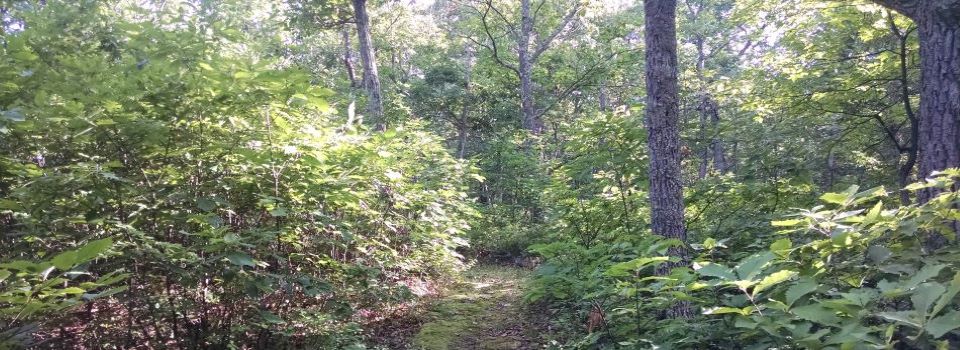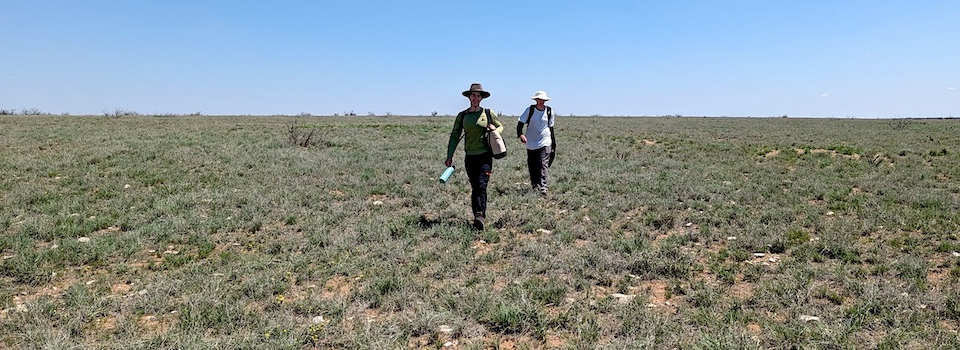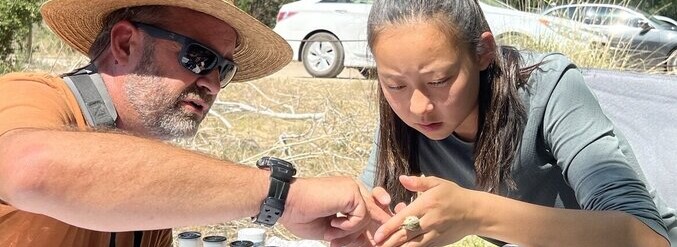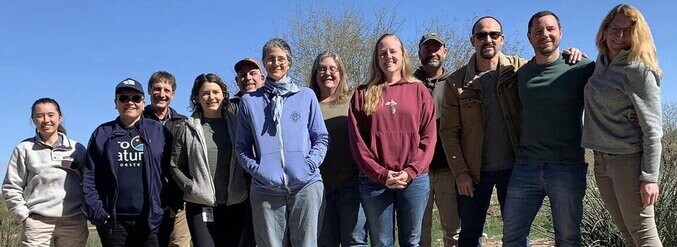Since our formation in 2008, the Appalachian Mountains Joint Venture (AMJV) has worked to build partnerships to conserve, manage, and restore the health of forest habitat in the Appalachian region. Our vision is to have effective, collaborative partnerships for habitat conservation across the entirety of our Joint Venture geography. However, it requires tremendous capacity to foster these complex relationships across such a large area and, like many of our partners, the AMJV faces funding and capacity constraints that limit the amount of partnership support and habitat conservation we can deliver.
Effective habitat conservation is further complicated in our region because, unlike in the western U.S. where much of the land is federally-owned, land in the Appalachian region is a complex blend of federal, state, and private ownership; some of these owners manage their lands with habitat conservation in mind, but many do not. Birds and other wildlife don’t recognize our man-made ownership boundaries, and they often require large sections of contiguous forest habitat or various habitat types and age classes in proximity to one another (e.g. patches of young forest interspersed with mature forest), which can be difficult to achieve when working within a single property or ownership.
Focal Landscapes – They’re for the Birds
The AMJV Focal Landscape Initiative is aimed at addressing all of the above-mentioned capacity and conservation challenges that we face in our region. The Focal Landscape Initiative is an effort to target our capacity to high-priority regions, strategically focusing our resources on encouraging landscape-scale collaboration and habitat conservation in landscapes that are important to the conservation of priority bird species. Landscape-level coordination bridges the gap between best management practices that offer guidance on how to create habitat for those species at the stand-level and plans that identify priority species at the state-level or regional-level. This “missing piece” can guide land managers in deciding: how to manage for certain species; which species their management should focus on; and where and at what scale to plan management relative to other habitat availability in the neighboring landscape.
The AMJV Focal Landscape Initiative is being developed in parallel with the American Bird Conservancy’s (ABC) BirdScapes program. Mike Parr, ABC’s president, describes BirdScapes as “large-scale priority areas for habitat management to support the conservation of migratory birds” and “areas at the junction of science and opportunity.” These succinct, yet powerful descriptions of BirdScapes and focal landscapes emphasize the importance of these areas being in locations that best-available science tells us are valuable for priority bird species and where there is conservation work occurring that could benefit from increased collaboration and support (learn more from the Spring 2017 edition of ABC’s Bird Conservation Magazine). It is important that focal landscapes contain a mix of public and private lands and have a variety of active partners working in the area, especially private and industry sector partners. Other factors important in the selection of focal landscapes include funding prospects, connectivity to wintering grounds, active research, and existing conservation plans.
…and for Ecosystems
Although improving habitat for AMJV priority bird species is an overarching objective and starting point for our work in focal landscapes, an advantage of the Focal Landscape Initiative is in recognizing that the best way to meet this objective is to holistically manage for the diversity and health of the entire ecosystem and local communities in which these species occur, over a long period of time. By shifting from single-species management to a more comprehensive approach, we are able to more effectively integrate bird conservation objectives with forest restoration efforts and can engage a broader coalition of partners in our work. For example, messaging our bird conservation work as “increasing age class and structural diversity of forests” can be easier to align with the current work of a forestry agency than “managing for Cerulean Warblers” would be. Engaging a diversity of partners with objectives that are not bird-centric – forest restoration, for example – will ultimately benefit AMJV priority species while providing a host of other environmental benefits as well.
…but Partners Benefit, Too
Participation in the Focal Landscape Initiative facilitates partners in collaborating on high-priority projects, effectively getting the most “bang” for their conservation “buck.” Not only do focal landscape partners benefit from potentially sharing (and thus reducing) project implementation costs, they may also gain access to increased funding opportunities by working together with other partners on grant applications for which their stand-alone projects might not have been otherwise eligible. Coordinated efforts can also lend to stronger grant applications (akin to having multiple co-signers on a loan) and can improve efficiency by limiting within-partnership competition for funding. Moreover, coordinated landscape-scale management through the focal landscape partnership may be attractive to potential funders and could encourage the development of additional funding opportunities within the focal landscapes, similar to the National Fish and Wildlife Foundation’s (NFWF) Central Appalachia Habitat Stewardship Program.
Partners working collaboratively in focal landscapes also gain access to the knowledge, skill-sets, resources, and networking relationships that other partners bring to the table as well as to landscape-scale planning tools that are developed in coordination with AMJV staff and other partners. Each partner has different strengths and resources, and landscape-level coordination helps each of them understand how the management, protection, outreach, and other services they provide fit into the bigger picture for priority species conservation. For example, a small land trust may manage a 30-acre property. It may not be possible for them to achieve a balanced age class distribution on their forested property alone, but perhaps they can complete a 10-acre harvest on their property that becomes part of a matrix of young forest patches on a neighboring property. The focal landscape approach helps highlight and elevate the importance of each partner’s efforts as parts of a larger whole. Furthermore, once focal landscapes are established, non-traditional partners such as local schools, watershed organizations, and businesses, can be invited to participate in conservation efforts as well, thus engaging the whole community in working towards a healthy, diverse landscape.
Focal Landscapes Have Unique Structure and Development
Giving strength to the AMJV Focal Landscape Initiative is the fact that it is a “ground-up” effort, with local partners leading the development of individual focal landscapes across the AMJV geography and identifying the overarching objectives for each landscape, especially priorities that are not bird-centric. This results in each focal landscape taking on its own unique structure, determined by partners and their objectives, land ownership, communities, geographic characteristics, and resources in the local area. The role of AMJV staff in this process is to support and advise work as needed, especially with tasks such as meeting facilitation, landscape-level planning (e.g. data analysis and visualization), encouraging continued partner communication and coordination, and sharing partner success stories.
While each focal landscape is unique in how it develops, the process generally follows the framework of first being identified by an AMJV partner as an area of interest, followed by AMJV staff having discussions with local partners to gauge their interest in establishing a focal landscape in the region. If there is local partner support, the AMJV then leads the partners in determining their shared priorities and goals for the landscape and discussing their needs for landscape-level planning. These discussions guide the AMJV in developing landscape-level decision support tools and facilitate partners in generating a prioritized list of habitat management or protection projects. Steps in the focal landscape development process might include: identifying a preliminary focal landscape boundary; establishing a focal landscape lead contact and Planning Committee members (generally about 12-20 partners); holding an initial Planning Committee meeting to gain buy-in from local partners, formally establish the partnership, and generate a list of data that the Committee will need in future meetings to assist with boundary and priority setting; utilizing landscape-level planning tools, including maps, to finalize focal landscape boundary (which may span multiple state lines) and identify focal landscape goals, both short- and long-term; prioritizing project ideas; identifying additional partners; applying for joint funding; establishing active forest management on the ground once funding is secured; and monitoring and evaluating projects in regards to their impact on habitat conservation and environmental benefits.
Get Involved in the Vision
Currently, there are six active focal landscape partnerships within the AMJV geography in Ohio, Virginia, West Virginia, New York, and Pennsylvania, including two ABC BirdScapes led by Dr. Jeffrey Larkin. Another three focal landscapes are under development in Kentucky, Tennessee, and North Carolina. Our vision for the Focal Landscape Initiative is to have at least one active focal landscape in each of the 12 states within our Joint Venture geography. Partners can get involved in the Focal Landscape Initiative in a variety of ways, including serving as a lead organization, dedicating staff time to serving as chairperson or attending focal landscape meetings, sharing data and planning resources in focal areas, letting AMJV know of any areas that your organization views as having high potential for focal landscape development, and, last but certainly not least, helping to spread the word about the Focal Landscape Initiative and communicating with AMJV about how we can improve this initiative to best serve our partnership.
Photo Credit: Amanda Duren







